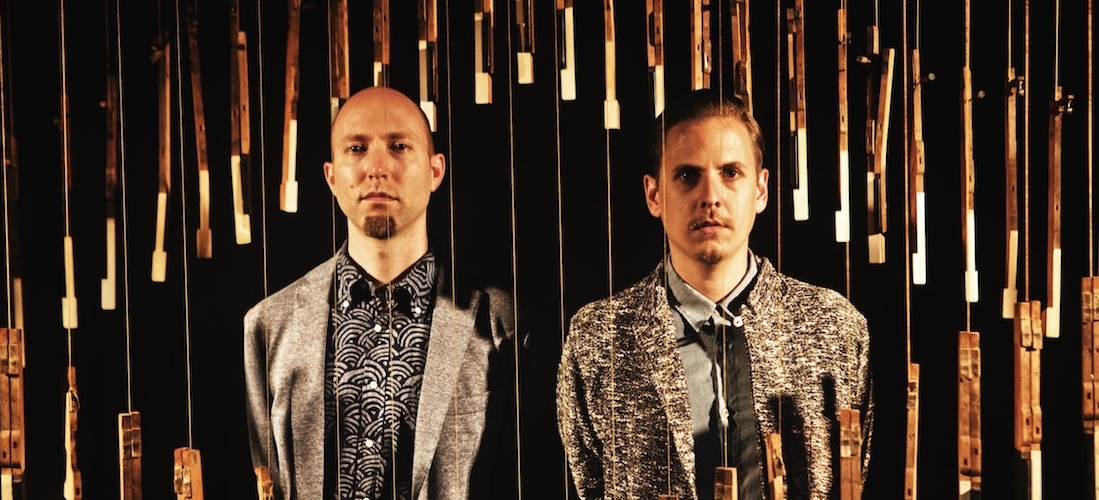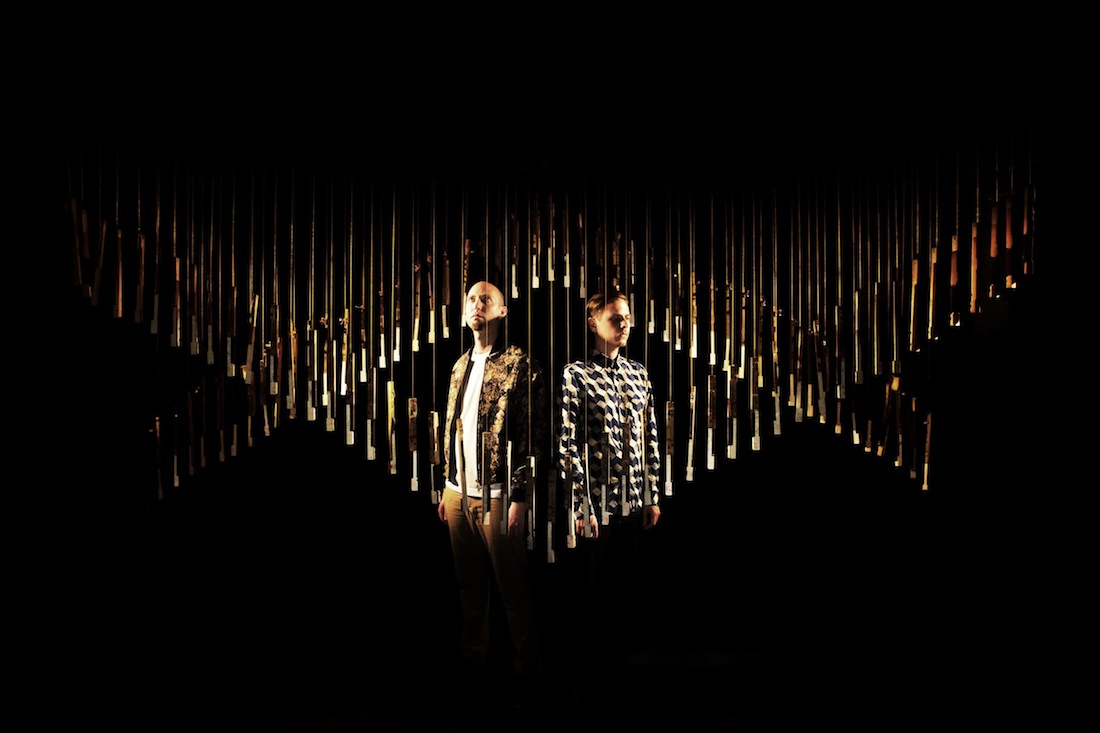Interview: LV
On the new 'Ancient Mechanisms,' Simon Williams and Will Horrocks head down the road less traveled.

Interview: LV
On the new 'Ancient Mechanisms,' Simon Williams and Will Horrocks head down the road less traveled.

“We’re constantly trying to make something as popular as Taylor Swift, and we feel we really may have nailed it with this one,” says Will Horrocks, one half of London electronic-music polymaths LV. “It’s all a cynical ploy; it’s just very badly executed,” adds his production partner Simon Williams. Their delivery may be dry, but LV’s music is anything but; the pair might pepper their conversation with humorous asides, their sound is serious. Luckily, the group’s detailed, vivid beats are nothing like the aforementioned pop singer (apologies all you Taylor Swift fans out there). Instead, they’ve assiduously assembled a body of work that would make most devotees of left-field dance stop in their tracks.
Whether it’s the fidgety two-step funk of their debut album Routes for trusted U.K. imprint Keysound—made with spoken word poet and MC Josh Idehen—or Sebenza for Hyperdub, which saw them dump pixelated splashes of bright sonic pigments on kwaito house and collaborate with South African rappers like Okmalumkoolkat, theirs has been the path less trodden. Their latest, this time for BBC Radio 6 Music tastemaker and renowned globetrotter Gilles Peterson’s Brownswood label, is called Ancient Mechanisms—and it’s another departure. This time around, they’ve hooked up with respected Armenian pianist Tigran Hamasyan, a successful jazz musician who appears on five of the album’s 14 tracks.
If that sounds like they’ve self-consciously diverted down the jazz aisle, the truth is more nuanced; “Hammers and Roses,” for instance finds lush melodic piano passages doing battle with bumping garage beats and psychedelic warps of backwards synth, while “Jump and Reach” a portly, frenzied slab of broken house with laser bleeps serrating distorted, grooving jazz keys. Williams and Horrocks themselves are certainly wary of the jazz tag, though they use their sense of humor to disarm any barbs. “Neither of us go in for listening to one particular kind of music,” Williams states. “We like to listen to really banging club tunes, and also tunes that are out-there jazz odysseys. Depending on what kind of mood you’re in.”
“You mean out-there jazz odysseys aren’t banging club tunes?” Horrocks deadpans. “Well yeah, they can be,” Williams ponders. “You’re so proscribed,” the former jokes, before getting serious again. “There’s a lot of electronic music in general that, once you starting bringing a jazzy element into it, it can be a bit on the flaccid side. There’s a lot of music I enjoy that gets described as jazzy, but I always thought it was a bit of a poisoned chalice, as it tends to mean a bit vapid. From that point of view we wanted to go with somebody who shared our understanding of what jazz music is. And I think Gilles certainly has that in terms of his attitude towards it, which is kind of more punky than it is smooth jazz.”
It’s an experimental edge that Hamasyan brings to the project, though his virtuosity is scattered economically over Ancient Mechanisms, rather than being overbearing. He linked with LV after the three were brought together to do a live session for Peterson’s radio show. It worked; the decision was made to extend the collaboration, and Brownswood was a natural home for the record. With all of the musicians having a broad-minded approach, they found their contributions gelled well. “One of the reasons [Hamasyan’s] so successful in the jazz world is that he doesn’t sound like a traditional jazz pianist,” Horrocks believes. “He’s got elements of his playing that come from the Armenian angle, although I would hesitate to fully ascribe him to that, because he’s more than the sum of his cultural heritage. But that’s one of the reasons for his phenomenal success, that he’s quite unusual in how he builds melodies and chord structures.

“If you put some of his playing through a guitar-amp emulator,” Horrocks continues, “it sounds like serious rocky stuff as well. He’s definitely into some pretty out-there guitar-based stuff, so a lot of the arpeggios do owe a little bit…I guess in the way that super-technical rock music owes a bit to classical playing, he’s got that common root.”
Finding a new collaborator wasn’t the only change in the recording of the duo’s latest record. Leaving London behind, and departing for Belgium and remote Morocco, they became fascinated by the sound of the piano and obsessed over its multiple resonating frequencies. Heading to a piano museum in the town of Ruiselede in Flanders to record the quirks of its extraordinary collection yielded spectacular results—and also the album’s title.
Getting into the nature of the sound and the idea of the piano as a machine, they were struck by the evergreen quality of this most enduring device. “When we first got there, we went round with Tigran trying out all the different pianos,” Williams remembers. “They had a ludicrous number of incredible 20th-century, beautiful pianos from all different places—Germany, France. The difference in the sound from one to the other was pretty striking, and it took us a little while to settle on which had the best sound for what we wanted to do. Even in a case like that when you’ve got 20, 30 pianos…there’s a huge amount of variation, and it’s interesting to get into and to focus in on specific sounds for pianos and what you like about them and don’t like about them, and then recreate them in the recording process.”
“When we’ve recorded pianos in previous situations, we’ve normally had somebody to do it for us,” Horrocks says. “But for this one we took a load of mikes, a laptop and a couple of soundcards out to this place. We had to make it up a bit as we went along. We’d done a reasonable amount of research and we have got experience recording stuff, but through having to physically clamber around inside pianos, you realize that the piano sound you normally think is an archetypal piano sound is just one element of how it comes together.”
“No two pianos are the same, and crawling around inside of them and miking them up with contact mikes, you do get a rich universe of noise which is much denser and more interesting than just the Logic sample piano.”
They discovered that sound quality wasn’t necessarily the most appealing aspect of a piano either—but instead it could be the environment in which it sits, and even its individual character or life. “We started to appreciate the sound of different sorts of pianos and how they differ from one another,” Horrocks says. “And also things that are not classically great-sounding pianos started to appeal to us as well. There was a piano in Morocco in a place where we were recording, it was quite a specific-sounding piano because of the room it was in, the place it was in, the life it had lived up to that point. You start to see how each of these things are their own. No two pianos are the same, and crawling around inside of them and miking them up with contact mikes, you do get a rich universe of noise which is much denser and more interesting than just the Logic sample piano.”
This travel yielded other sounds beyond the musical too, as Horrocks and Williams became intent on capturing the aural quality of their immediate surroundings. They wandered the streets of Brussels looking for percussive and background noises they could use as found sounds to add a backdrop to Ancient Mechanisms—something which imparts no end of atmosphere. The shivery, elegiac feel of “Detent,” for instance, with its background rustle of street sounds, encourages the listener to pull their coat closer. “You just do things differently when you’re out of that studio environment,” Horrocks says. “There’s a lot of sounds on there that we recorded, found-sound style, walking around hitting things around Brussels. Those sounds, you’re not gonna get ’em if you sit in your studio the whole time. As much as anything else it’s freshening things up, and exposing yourself to different environments naturally creates a different sound.”
It’s LV’s restless curiosity that drives them to something new each time out. Being into all kinds of music, they’ve no desire to repeat themselves, and aren’t bound by a typical club DJ’s need to have ammunition for their set constructed from the same materials over and over. “I don’t want to be that guy who says ‘I never make the same record twice’,” Horrocks says carefully. “I try not to, but you do occasionally make similar sorts of music. But we’re definitely not wanting to bore ourselves by feeling like we’re just doing the same thing over and over again. Whether that is imposing a structural rule of how you’re going to make something, or finding new collaborators, even moving your studio from one physical location to another, it shakes things up a bit. Not that making music is boring, but life is more interesting if you do different things.
“Also I know that a lot of people who do make the same music over and over are driven by a need to just have fodder for DJ sets. And because we get booked in a variety of different sorts of environments and places to DJ, we get away with playing less of a constricted range, which feeds into being able to make whatever sort of thing we really want. Instead of thinking, ‘Shit, I’ve got to make everything at 125 because that’s what I play’.”
Four albums deep, LV has already achieved a hell of a lot—and the next step is a more ambitious one into the live domain, attempting to recreate Ancient Mechanisms live. And after that? Horrocks has a plan, even if it’s not to be entirely believed. “On a very basic level we’ve never been No.1 in the album charts for eight solid weeks, so we keep having to do something different in the vain hope that the next album will be the one that catapults us into massive financial success.”
Top photo: Fabrice Bourgelle

